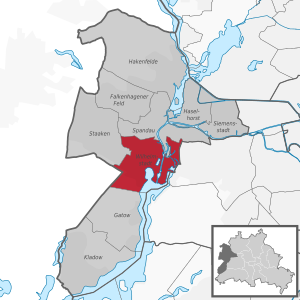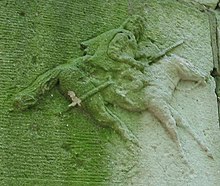Berlin-Wilhelmstadt
|
Wilhelmstadt district of Berlin |
|
|---|---|
| Coordinates | 52 ° 31 '16 " N , 13 ° 11' 48" E |
| surface | 10.422 km² |
| Residents | 40,536 (Dec. 31, 2019) |
| Population density | 3889 inhabitants / km² |
| Post Code | 13593, 13595 |
| District number | 0509 |
| structure | |
| Administrative district | Spandau |
| Locations | |
The Wilhelm City is a Berliner locality in the district of Spandau , whose name of Emperor I. Wilhelm derived. On the occasion of the emperor's 100th birthday, the former Potsdam suburb was given its current name in 1897.
Geography and history
The district is delimited in the north by the Bullengraben and along the Ruhlebener Straße / Charlottenburger Chaussee , in the east by the Havelchaussee and the Stößenseebrücke at Stößensee towards Westend , in the south by an east-west running line south of the Jaczo Tower towards Gatow and in the west by the sand road towards Staaken . Important roads in Wilhelmstadt are Heerstraße ( Bundesstraße 5 and east to Wilhelmstraße also Bundesstraße 2 ), Wilhelmstraße (south from Heerstraße, Bundesstraße 2) as well as Gatower Straße and Pichelsdorfer Straße .
In addition to the closed apartment building development in the historic Wilhelmstadt (north of Heerstraße) and the areas between Heerstraße and Weinmeisterhornweg, which are predominantly built with single-family houses, the localities of Pichelsdorf , Pichelswerder and Tiefwerder (without the southern port and residential area on Dorfstraße) also belong to this Spandau district.

The so-called "Seeburger Zipfel" also belongs to the district of Wilhelmstadt. In 1945 the Allied forces from the Soviet Union and Great Britain carried out an exchange of interests, including between Seeburg and the Berlin district of Spandau . At that time, Seeburg extended up to a few meters from the Havel , so that the southern areas of Spandau ( Gatow and Kladow ) could only be reached by road ( Potsdamer Chaussee , Gatower Straße) from Wilhelmstadt via the area of Seeburg in the Soviet occupation zone. The British operated their military airfield and two barracks in the south of Spandau and wanted to have unhindered access. Therefore, the Seeburger Zipfel was assigned to Spandau. It includes the Weinmeisterhöhe residential area near the Havel , today the residential area with the highest land prices in Spandau, and the Rieselfelder . Spandau areas west of Potsdamer Chaussee (Rieselfelder) were assigned to the municipality of Seeburg to a lesser extent. The Seeburger Zipfel now forms the Seeburg district in Wilhelmstadt. With the unification agreement , it was decided at German reunification that the exchange areas Seeburger Zipfel and Groß Glienicke remain in the Spandau district. A constitutional complaint by the community of Groß Glienicke was unsuccessful. The western part of the Staaken district, which was handed over to the Soviet occupation zone in 1945, had been an independent municipality of Staaken in the GDR since 1961 and came back to Spandau in 1990.
The district gained international fame from 1947 when the Nazi war criminals Karl Dönitz , Albert Speer and Rudolf Hess were imprisoned in the local war crimes prison. The prison was located on the southwestern edge of Wilhelmstadt and was subordinate to the Allied Control Council , with the prisoners being guarded every month by the former Allies . In 1987, after the suicide of the last and for years only prisoner, Rudolf Hess, the prison was torn down immediately so as not to turn it into a place of pilgrimage for right-wing extremists . The site was redeveloped with a shopping center opened in 1990 , the former Britannia Center Spandau of the NAAFI . In 2011, as the new owner, a development company applied for the demolition of the cinema complex of the former Britannia Center. The leases for the cinema complex and the shopping complex were terminated. In 2013, a comprehensive partial demolition and redesign in the form of a single supermarket building for the discounter Kaufland followed .
The Kombibad Spandau-Süd (Uwe-Gaßmann-Bad, Gatower Straße 19) of the Berlin baths is located in Wilhelmstadt . Two former large barracks on Wilhelmstrasse have been used for commercial purposes since the withdrawal of the British armed forces .
The world's only "wet" low noise simulation facility is due to the sharp Lanke on the southeastern edge of Wilhelm city. The DLRG Berlin can with its diving tower system of Research and Education site (BLFS) depths up to 150 meters of water to simulate. Recreational divers can experience the dangers of deep intoxication under safe conditions and diving accidents are treated.
Sights and memorials
Jaczo Gorge
At Gatower Straße 199 - shortly before you reach Gatow - a path through the Jaczo Gorge to the Havel begins. After only a few meters you come across a small, round, inconspicuous and neglected tower . It was built in 1914 with the private funds of an anonymous Spandau citizen in memory of the Slavic prince Jaxa von Köpenick , who also gave the gorge its name. Jaxa or Jaczo went down in history as an opponent of Albrecht the Bear when the Margraviate of Brandenburg was founded in 1157. A relief on the tower that has already fallen apart shows Jaxa fleeing from Albrecht the Bear and two of his riders. According to the legend and the Latin inscription, Albrecht is said to have driven the Slav prince into the Havel at the end of the gorge. He only reached the saving bank opposite at Schildhorn with the help of the Christian God - whom he had called upon in the last distress and hated so far - to whom he swore his loyalty in thanks. King Friedrich Wilhelm IV of Prussia had a monument erected near Schildhorn in 1845 in memory of Jaxa's miraculous conversion.
Landscape protection and monuments
Other sights include the conservation area Tiefwerder meadows on the Havel, the last natural flooding and Hecht - spawning area in Berlin.
See also
- List of streets and squares in Berlin-Wilhelmstadt
- List of cultural monuments in Berlin-Wilhelmstadt
- List of stumbling blocks in Berlin-Wilhelmstadt
Web links
- Uwe Gerber: News about the Jaczo Tower . In: The Grunewald in the Spiegel der Zeit , July 25, 2014
Individual evidence
- ↑ Berlin Bulletin , Volume 41, No. 9, March 2, 1990.
- ↑ Shopping center in a new look . ( Memento of the original from March 30, 2012 in the Internet Archive ; PDF; 9.9 MB) Info: The archive link was inserted automatically and has not yet been checked. Please check the original and archive link according to the instructions and then remove this notice. In: Spandauer Volksblatt , August 10, 2011, p. 4




